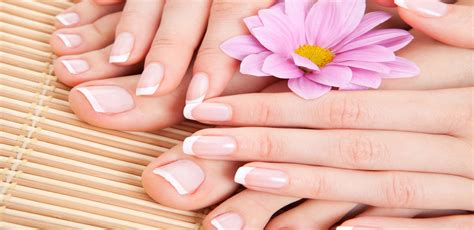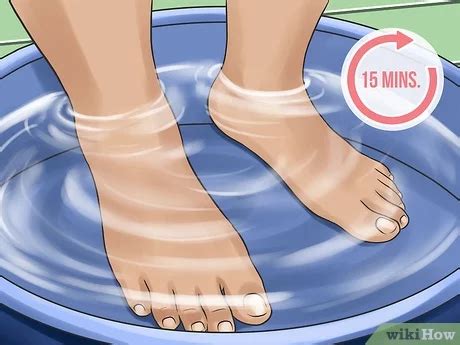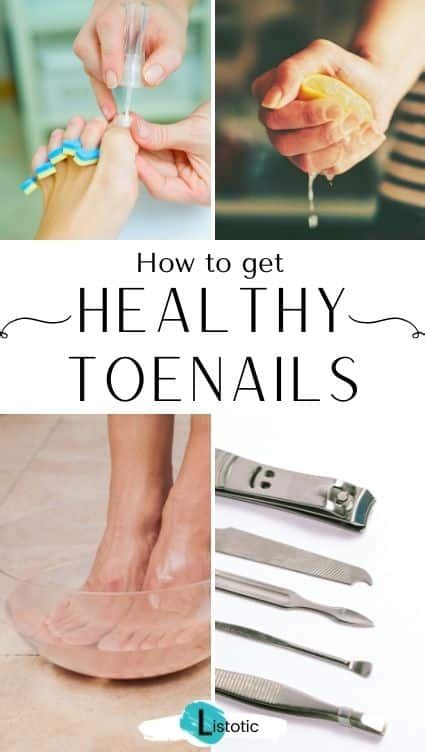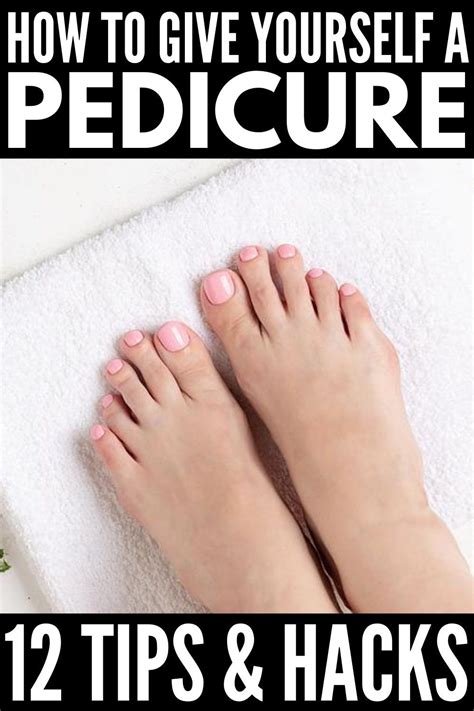At times, we all yearn for nails that exude a sense of vitality and cleanliness. There is something undeniably rejuvenating about having toenails that are a vision of health. By paying attention to the well-being of our nails, we can enhance their appearance and ensure their longevity. Whether you desire a perfect pedicure or simply want to improve the condition of your nails, there are several key tips to keep in mind.
Priority No. 1: Never overlook the significance of hygiene when it comes to nail care. Cleaning your toenails meticulously is not only crucial for aesthetic purposes, but it also plays a pivotal role in maintaining their health. Establishing a regular routine for cleansing and trimming your nails is an essential step towards achieving the desired results.
Tip No. 2: Pay heed to the power of proper nutrition. Just as a balanced diet contributes to overall well-being, it also plays a role in the health of our nails. Including a variety of essential nutrients, such as vitamins, minerals, and proteins, in our daily intake can significantly enhance the strength and appearance of our toenails.
The Significance of Maintaining Good Nail Health and Hygiene

Proper care and hygiene of our nails play an essential role in promoting overall health and wellness. By giving attention to our nails, we can prevent various infections, maintain their strength and appearance, and be more confident in showing off our hands and feet.
When it comes to nail care, attention to detail is crucial. Regular cleaning, trimming, and moisturizing are necessary to keep our nails in their best condition. Neglecting nail health can lead to bacterial or fungal infections, brittle nails, and unsightly discoloration, which can all adversely affect our overall well-being.
One of the key aspects of nail hygiene is proper cleaning. Regular washing of hands and feet, especially focusing on the nails and cuticles, helps remove dirt, bacteria, and germs that can accumulate throughout the day. Additionally, using an antibacterial soap or hand sanitizer can provide an extra layer of protection.
Trimming nails regularly is another important aspect of maintaining good nail health. Overgrown nails can easily trap dirt and bacteria, increasing the risk of infection. Proper nail trimming techniques, such as cutting straight across and avoiding excessively short cuts, can prevent painful conditions like ingrown nails.
Keeping nails moisturized is equally essential. Dry and brittle nails are more susceptible to breakage and damage. Applying a nourishing cuticle oil or moisturizer to the nails and surrounding skin can help retain moisture, strengthen the nails, and promote healthy growth.
In conclusion, prioritizing nail health and hygiene is vital for overall well-being. By incorporating regular cleaning, proper trimming, and adequate moisturizing into our nail care routine, we can prevent infections, maintain strong and beautiful nails, and exude confidence in showcasing our hands and feet.
Dealing with Common Nail Issues: Essential Tips for Maintaining Nail Health
In this section, we will explore various common problems that can affect the health and appearance of your nails. By understanding these issues and following simple preventive measures, you can ensure your nails stay in optimal condition.
1. Fungal Infections:
- Prevent moisture buildup by keeping your feet dry.
- Avoid sharing nail care tools to reduce the risk of contamination.
- Choose breathable footwear and wear protective footwear in public areas.
2. Ingrown Nails:
- Cut nails straight across and avoid rounding the edges.
- Wear well-fitted shoes to prevent pressure on the toes.
- If you notice signs of an ingrown nail, seek professional help to prevent infection.
3. Brittle Nails:
- Avoid excessive exposure to water and use gloves while cleaning or doing dishes.
- Maintain a balanced diet rich in essential vitamins and minerals.
- Apply moisturizing nail products regularly to strengthen the nails.
4. Nail Discoloration:
- Refrain from using harsh chemicals and dyes on your nails.
- Protect your nails from sun exposure using nail polish with UV protection.
- If you notice persistent discoloration, consult a dermatologist for a proper diagnosis.
5. Nail Biting:
- Find alternative stress-relief techniques to avoid nail biting.
- Keep your nails well-trimmed and maintain an appropriate length.
- Consider using a bitter-tasting nail polish to deter the habit.
By implementing these tips and being mindful of your nail health, you can prevent common nail problems and enjoy healthier, more beautiful nails.
Keeping Your Toenails Pristine: Effective Methods for Maintaining Clean and Bacteria-Free Nails

Good hygiene is important for overall well-being, and this includes proper care for your toenails. Maintaining clean and bacteria-free toenails is crucial in preventing infections and promoting healthy nails. By following a few simple practices and incorporating them into your daily routine, you can keep your toenails in top-notch condition.
1. Regular Toenail Cleaning: Regularly cleaning your toenails is essential to remove dirt, debris, and bacteria that can accumulate on the surface. Use a gentle brush and a mild soap to clean under and around the nails. Be sure to dry them thoroughly to prevent moisture from creating an ideal environment for bacteria to thrive.
2. Proper Nail Trimming: Trim your toenails regularly to maintain a clean and neat appearance. Use a clean, sharp nail clipper, and ensure that you cut straight across rather than rounding the corners. This helps prevent ingrown toenails and reduces the risk of bacterial infections.
3. Wear Appropriate Footwear: Choosing the right footwear is crucial in preventing the accumulation of dirt and bacteria on your nails. Opt for shoes that provide adequate ventilation and avoid tight-fitting or non-breathable shoes that can create a moist environment. Additionally, wearing clean socks made of breathable materials helps keep your toenails dry and free from bacterial growth.
4. Apply Antifungal Products: To maintain clean and bacteria-free toenails, consider applying antifungal products regularly. These products help prevent and treat fungal infections, which can lead to discolored or brittle nails. Follow the instructions provided with the product for best results.
- Look for antifungal creams or ointments that specifically target nail infections.
- Consider using antifungal foot powders to help keep your feet dry and prevent fungal growth.
5. Avoid Sharing Personal Nail Care Items: Sharing nail clippers, files, or other personal nail care items can increase the risk of spreading bacteria or fungal infections. To maintain optimal nail health, it is essential to use your own tools and avoid sharing them with others.
6. Maintain a Balanced Diet: A healthy diet can contribute to strong and healthy nails. Including foods rich in vitamins, minerals, and essential nutrients can promote nail growth and prevent common nail problems. Incorporate foods like eggs, nuts, spinach, and fish to ensure you are providing your nails with the necessary nutrients.
By following these steps and incorporating them into your nail care routine, you can keep your toenails clean and free from bacteria, promoting their overall health and appearance.
The Dos and Don'ts of Trimming and Shaping Toenails
Properly cutting and trimming your toenails is crucial for maintaining overall foot health and preventing common issues such as ingrown toenails and infections. Understanding the dos and don'ts of toenail care ensures that you achieve the best possible results and keep your toenails looking and feeling their best.
The Dos:
1. Trim your toenails regularly: Regular trimming helps prevent the nails from becoming too long and minimizes the risk of them becoming ingrown.
2. Use clean and sanitized nail clippers: Make sure to use nail clippers that are specifically designed for toenails and keep them clean and sanitized to avoid introducing bacteria into the area.
3. Cut straight across: When trimming your toenails, cut them straight across to prevent them from growing into the skin on the sides, which can lead to painful ingrown toenails.
4. Leave a slight edge: It's important to leave a small edge when trimming your toenails to prevent them from growing too far into the skin.
5. Keep your toenails dry and clean: Moisture can contribute to the growth of fungi and bacteria, so make sure to dry your toenails thoroughly after washing and keep them clean to reduce the risk of infection.
The Don'ts:
1. Don't cut your toenails too short: Cutting your toenails too short increases the likelihood of them growing into the surrounding skin, causing pain and potential infection.
2. Avoid pointed or rounded nail shapes: Opt for a square or slightly rounded shape when trimming your toenails to reduce the risk of ingrown nails and discomfort.
3. Don't ignore signs of infection: If you notice any redness, swelling, pain, or discharge around the toenail area, seek medical attention as it may be a sign of an infection that requires treatment.
4. Avoid sharing nail clippers: Sharing nail clippers can spread fungal or bacterial infections, so it's best to use your own clippers and avoid sharing them with others.
5. Do not bite your toenails: Biting your toenails can introduce bacteria from your mouth into the nail bed, increasing the risk of infection.
By following these essential dos and don'ts of cutting and trimming toenails, you can promote healthy nail growth and maintain the overall health of your feet.
The Essential Tools and Products for Maintaining Healthy Toenails

In this section, we will explore the must-have tools and products that are crucial for achieving and maintaining the overall health and wellness of your toenails. These items not only help you achieve beautiful and strong nails, but they also contribute to the prevention of nail damage and infections. By investing in high-quality tools and products, you can ensure that your toenails remain strong, clean, and free from common issues like fungus and brittleness.
1. Nail Clippers
Nail clippers are a fundamental tool for keeping your toenails in shape. Look for ones with sharp and durable blades to make precise cuts and avoid accidental snags or splits. It's recommended to choose a size and shape that matches your nail bed for easier and comfortable trimming.
2. Nail File
A nail file is an essential tool for shaping and smoothing the edges of your toenails. Opt for a high-grade emery board or glass file, as they provide excellent control and ensure a consistent finish. Emery boards are suitable for natural nails, while glass files work well for both natural and artificial nails.
3. Cuticle Nippers
Cuticle nippers are handy for removing excess skin and maintaining clean and healthy cuticles. Choose ones with a sharp and sturdy cutting edge, allowing you to remove dead cuticles without causing any pain or damage. Regularly moisturizing your cuticles and gently pushing them back promotes healthier nail growth.
4. Nail Strengthener
A nail strengthener is a beneficial product to reinforce weak and brittle toenails. These products work by providing essential nutrients and strengthening agents to nourish and protect the nails. Look for a strengthener that suits your specific needs, such as a formula enriched with vitamins, minerals, or proteins.
5. Antifungal Treatment
An antifungal treatment is crucial for preventing and combating nail fungus. If you notice any signs of discoloration, thickening, or flaking of your toenails, it's important to address the issue promptly. Look for an antifungal treatment that contains ingredients like tea tree oil, clotrimazole, or undecylenic acid, as they are effective against various types of fungal infections.
6. Nail Brush
A nail brush is an effective tool for maintaining cleanliness and hygiene. Regularly scrubbing your nails and the surrounding skin helps remove dirt, dead skin cells, and bacteria, reducing the risk of infections. Look for a brush with medium to firm bristles that can reach into the nail crevices without causing irritation.
7. Moisturizing Cream
A moisturizing cream specifically designed for nails and cuticles is essential for keeping them hydrated and nourished. Regularly applying a quality moisturizer helps prevent dryness and brittleness, promoting overall nail health. Choose a cream with ingredients like shea butter, jojoba oil, or vitamin E for maximum moisturizing benefits.
By incorporating these essential nail care tools and products into your daily routine, you can achieve and maintain healthy toenails that are not only aesthetically pleasing but also resistant to common issues that can affect their health and appearance.
Keeping Toenails Hydrated and Preventing Dryness
Proper moisture balance is essential for maintaining healthy toenails. Dryness can lead to brittle, weak nails that are prone to breakage and splitting. To ensure your toenails stay moisturized and free from dryness, it's important to follow a regular nail care routine and incorporate effective moisturizing practices.
Moisturizing Oils and Lotions
One effective way to moisturize toenails is by applying nourishing oils or lotions. These products help to restore moisture to the nails, preventing dryness and promoting healthier growth. Look for natural oils such as almond oil, jojoba oil, or coconut oil, which are known for their hydrating properties. Gently massage the oil or lotion into your toenails and surrounding skin, allowing it to absorb fully.
Hydrating Soaks
A relaxing foot soak can not only hydrate your feet but also work wonders for your toenails. Fill a basin with warm water and add a few drops of an essential oil like lavender or tea tree oil, which can provide additional benefits. Soak your feet for about 10-15 minutes, allowing the warm water to penetrate your nails and soften any dryness. Pat dry with a soft towel and moisturize immediately afterwards.
Balanced Diet and Hydration
The overall health of your toenails and the rest of your body is closely related. Maintaining a balanced diet and staying hydrated plays a crucial role in preventing dryness and promoting healthy nail growth. Include foods rich in vitamins A, C, and E, as well as biotin and omega-3 fatty acids, which are known to support nail health. Additionally, drink an adequate amount of water throughout the day to keep your body and nails hydrated.
Gentle Nail Care
Avoiding excessive use of harsh nail products and treatments is essential to prevent dryness in toenails. Opt for non-acetone nail polish removers and gentle nail care products that do not strip the natural oils from your nails. It's also important to handle your toenails with care, avoiding rough treatment and excessive filing or buffing.
Regular Moisturizing Routine
To maintain well-hydrated toenails, establish a regular moisturizing routine. Apply a moisturizer specifically designed for nails and cuticles daily, focusing on massaging it into the nail bed and surrounding skin. Don't forget to protect your feet and nails in dry or cold weather by wearing socks and moisturizing regularly.
By following these simple yet effective tips, you can ensure that your toenails stay moisturized and free from dryness, promoting their overall health and appearance.
The Role of Proper Nutrition in Maintaining Optimal Toenail Health

Ensuring the health and vitality of your toenails goes beyond simply keeping them clean and well-groomed. Paying attention to your diet and nutrition plays a significant role in maintaining the overall health of your toenails. By nourishing your body with the right nutrients, you can promote strong and resilient toenails that are less prone to common issues such as brittleness, discoloration, and fungal infections.
A well-balanced diet rich in essential vitamins, minerals, and proteins is crucial for promoting healthy toenails. Incorporating a variety of fresh fruits and vegetables into your meals provides your body with the necessary vitamins and antioxidants that support nail health. Additionally, consuming adequate amounts of lean proteins, such as fish, poultry, and legumes, helps to strengthen and repair damaged nails.
- Omega-3 fatty acids: Including sources of omega-3 fatty acids in your diet, such as fatty fish like salmon, can help improve the overall health and appearance of your toenails. These essential fatty acids are known to reduce inflammation and promote nail strength.
- Biotin: Biotin, also known as vitamin H, is a key nutrient that contributes to the maintenance of strong and healthy nails. Foods rich in biotin include eggs, nuts, seeds, and whole grains.
- Iron: Iron deficiency can result in brittle and weak nails. Adding iron-rich foods like spinach, lean red meat, and lentils to your diet can help maintain the optimal iron levels necessary for healthy nails.
- Zinc: Zinc is an essential mineral that aids in the production of proteins necessary for nail structure and growth. Foods high in zinc include oysters, beef, pumpkin seeds, and chickpeas.
In addition to incorporating these specific nutrients into your diet, it is essential to maintain overall hydration by drinking an adequate amount of water daily. Staying hydrated helps to prevent dryness and brittle nails, ensuring optimal toenail health.
By paying attention to your diet and nutrition, you can provide your toenails with the essential nutrients they need to thrive. Remember to consult with a healthcare professional or registered dietitian for personalized dietary recommendations based on your individual needs and health conditions.
Natural Solutions for Fungal Infections and Nail Issues
Embracing the power of nature can offer effective remedies for nail infections and fungus. By harnessing the potential of natural ingredients, you can enhance the health and appearance of your nails without relying on traditional treatments.
When it comes to tackling nail fungus and infections, natural remedies can provide a gentle yet powerful approach. These alternatives allow you to address the problem at its root, offering relief and promoting overall nail health.
One outstanding natural remedy is tea tree oil. Known for its strong antifungal properties, tea tree oil has been used for centuries to treat various infections, including nail fungus. Applying a few drops of tea tree oil directly onto the affected area can help combat the infection and prevent it from spreading further.
Another excellent choice is lavender oil, which not only possesses antifungal properties but also offers a calming and soothing effect. Lavender oil can be applied to the affected nails to promote healing and reduce inflammation, contributing to the overall health of your toenails.
Vinegar is also a natural ingredient that shows promising results in treating nail infections. Its acidic properties create an unfavorable environment for fungus to thrive. Soaking your nails in a mixture of warm water and vinegar for ten minutes a day can help eliminate the infection and promote healthy nail growth.
For an all-around natural solution, incorporating coconut oil into your nail care routine can be highly beneficial. Coconut oil is well-known for its moisturizing and nourishing properties. Regularly massaging coconut oil onto your nails and cuticles can help keep them strong, hydrated, and resistant to fungal infections.
While these natural remedies provide a gentle and effective approach to addressing nail fungus and infections, it is essential to remember that individual results may vary. It is always recommended to consult with a healthcare professional before attempting any new treatment.
Tips for a Safe and Effective DIY Pedicure in the Comfort of Your Home

Creating a relaxing and spa-like experience for your feet doesn't have to involve expensive salon visits. With a few simple tips and techniques, you can achieve a safe and effective DIY pedicure right at home. Taking care of your feet and nails is not only important for their overall health but also for their aesthetic appearance. By following these steps, you can maintain clean, well-groomed toenails without leaving your doorstep.
- Prepare your tools: Before starting your DIY pedicure, ensure you have all the necessary tools at hand, such as a nail clipper, nail file, cuticle pusher, and a pumice stone or foot scrub. Keeping these tools clean and sanitized is crucial to prevent any infections or bacteria from entering your nails or skin.
- Soak your feet: Begin your DIY pedicure by soaking your feet in warm water. Adding some Epsom salt or a few drops of essential oil can enhance the relaxing experience. Soaking your feet not only softens the skin but also helps in loosening any dirt or debris trapped in your toenails.
- Trim and shape your nails: Once your feet are relaxed, it's time to trim your nails to the desired length. Using a nail clipper, carefully cut straight across to avoid ingrown toenails. After trimming, use a nail file to shape the edges and smooth any roughness.
- Care for your cuticles: Gently push back your cuticles using a cuticle pusher or an orangewood stick. Avoid cutting the cuticles as they provide protection against infections. Applying some cuticle oil or moisturizer can help keep them hydrated and healthy.
- Exfoliate and moisturize: Scrub your feet using a pumice stone or foot scrub to remove any dead skin or calluses. Pay close attention to the heel and ball of the foot. After exfoliating, rinse your feet and moisturize them with a nourishing foot cream or lotion.
- Apply a base coat and nail polish: If you wish to add a pop of color to your toenails, apply a base coat before applying the nail polish. This helps protect your nails from staining and allows the polish to adhere better. Select your favorite nail polish shade and apply it evenly, allowing it to dry between coats.
- Finish with a top coat: Once the nail polish is dry, finish off your DIY pedicure with a high-quality top coat. This not only adds shine to your nails but also helps extend the longevity of your polish. Apply a thin layer and let it dry completely.
You don't have to be an expert to treat your feet with a safe and effective pedicure. By following these tips, you can achieve beautiful and healthy toenails in the comfort of your own home. Remember to prioritize cleanliness, proper tools, and taking your time to ensure a relaxing and enjoyable DIY pedicure experience.
FAQ
What are some tips for maintaining clean and healthy toenails?
There are several tips to maintain clean and healthy toenails. Firstly, it is important to regularly trim your toenails straight across to avoid ingrown nails. Additionally, keeping your feet clean and dry, especially in between the toes, can help prevent fungal infections. It is also advisable to wear clean socks and shoes that allow your feet to breathe. Lastly, regularly moisturizing your nails and cuticles can help prevent them from becoming dry and brittle.
How often should I trim my toenails?
To maintain proper nail care, it is recommended to trim your toenails every 2-3 weeks. However, the frequency may vary depending on the individual. If your nails grow faster, you can trim them more frequently. It is important to trim them straight across and avoid cutting them too short to prevent ingrown nails.
What are some common signs of fungal infections in toenails?
There are several common signs of fungal infections in toenails, also known as onychomycosis. These include thickened nails, yellow or brown discoloration, brittle or crumbly texture, distorted shape, and a foul smell. In some cases, the nails may also detach from the nail bed. If you notice any of these symptoms, it is advisable to seek medical attention for proper diagnosis and treatment.



